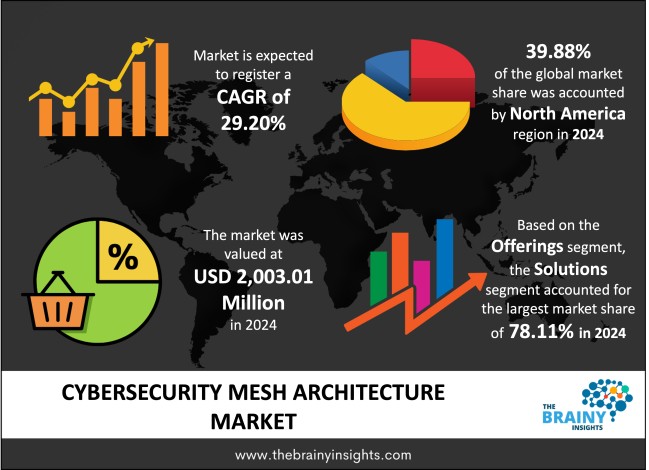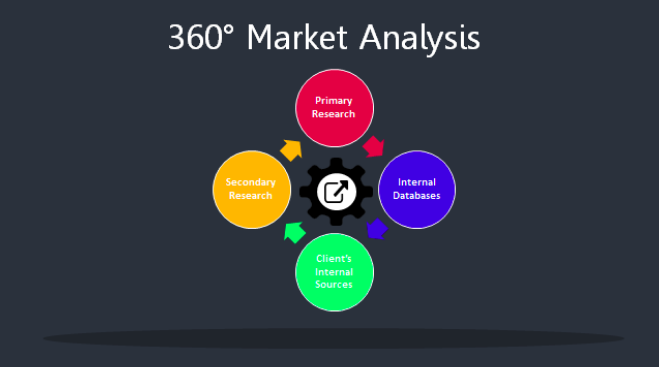- +1-315-215-1633
- sales@thebrainyinsights.com

The global Cybersecurity Mesh Architecture market was valued at USD 2,003.01 Million in 2024 and grew at a CAGR of 29.20% from 2025 to 2034. The market is expected to reach USD 25,956.60 Million by 2034. The market is driven by factors such as the growing complexity of cyber-attacks, which surpass the limitations of traditional cybersecurity methods. There are many uses of cybersecurity mesh, which adds flexibility, adaptability, and a strong security posture for organisations. The use of such architecture in IT development helps the organisation centralise security policy management. This led to a modular system which can be useful for many applications simultaneously. It supports both scalability and agility.
The cybersecurity mesh approach is very transforming to cybersecurity. It supports creating a protected boundary around identities, such as devices or humans, which is also a more flexible and adaptive security framework. This is a security system that is more dynamic and can adjust based on changing threats, risks, and environmental conditions. It can be very useful in safeguarding the growing diverse digital ecosystem, which includes multi-cloud networks and remote work settings. T can be very effective in dealing with costly and damaging cyberattacks. The separation of the decision-making component of security from the action-taking component led to centralised control of security policies, enabling the implementation of distributed and localised policies. Cybersecurity mesh uses the principle of mesh networking to create a distributed cybersecurity model. It is closely aligned with Zero Trust architecture, focusing on continuous authentication and authorisation. The use of micro-segmentation in cybersecurity improves cloud security and offers granular control over network access. Cybersecurity mesh architecture is a collective ecosystem of tools that control the security of an advanced and distributed enterprise. It builds on the policy of integrating composable, distributed security tools by centralising the data and control plane to facilitate more effective collaboration among tools.
The implementation of Cybersecurity Mesh Architecture provides numerous benefits and can be highly useful in addressing the current complex cybersecurity scenarios. It enables organisations to quickly adapt security measures in response to changing threats. Its agility is very important in scenarios where the threat vector is continually evolving. The implementation of a consistent security policy centrally decreases the potential security gaps. This approach minimises the risk of breaches and improves complete security efficacy. Cybersecurity Mesh Architecture helps in cost savings by decreasing the requirement for redundant security controls, leading to a better use of resources. This architecture supports optimising investment in cybersecurity as it tailors security measures to specific requirements and risks. Cybersecurity Mesh Architecture is very useful for growing and evolving organisations, as its modular nature enables the seamless addition of new components, eliminating the need to redesign the security infrastructure. Its scalability helps the organisation grow its security in tandem. Cybersecurity mesh offers a tailored security measure. Conventional security models offer blanket policies across the complete network, which leads to unrequired restrictions or ignored vulnerabilities. The use of cybersecurity mesh offers individualized security control, which can be carefully designed to the particular requirements and risks of each user or device.

Get an overview of this study by requesting a free sample
The surge in cyber threats– The need for Cybersecurity Mesh Architecture is growing due to a surge in cyber threats and the growing adoption of cloud services. The growth in the use of the Internet of Things (IoT) has led to its growing use. Another factor is the requirement for a more scalable, flexible, and resilient security architecture that can adapt to changing cyber scenarios. Cybersecurity Mesh provides an elastic and distributed approach to security. Additionally, there is a surge in the trend of remote work and cloud-based infrastructure, which has increased the need for a decentralised and flexible cybersecurity framework, ultimately driving the Cyber Security Mesh Architecture market. It enhances security for multiple endpoints and distributed networks, making it a crucial component in modern organisations' security architecture. Moreover, it also implements Zero Trust security models, which ensure continuous authentication and authorisation for every access request. There is a surge in the frequency and sophistication of cyber threats like ransomware and phishing attacks. Hence, Cybersecurity Mesh Architecture can offer adaptive security solutions. These factors are eventually propelling the growth of the Cybersecurity Mesh Architecture market.
Complex regularities and integration – The integration of cybersecurity tools from multiple vendors into a unified mesh framework can be very complex. Additionally, a stringent regulatory framework restricts the market's growth and raises concerns about data privacy in the deployment of decentralised security architecture, especially in organisations with strict compliance needs. Additionally, a shortage of resources and a lack of understanding in managing a distributed security architecture can also be a problem. A l these factors are acting as restraints for the market.
Need for scalable security solutions – There is a constant need for scalable security solutions in global organisations, and therefore, cybersecurity mesh adoption has significant potential. Some organisations work in diverse IT environments, including on-premise, cloud, and edge computing, and they utilise cybersecurity mesh architecture to enhance their security without compromising operational flexibility. Moreover, its AI-powered threat detection ability can provide better protection against more complex cyber-attacks and ensure faster incident response. It has been observed that large tech organisations are quickly adopting Cybersecurity Mesh Architecture. For instance, Google is utilising the Zero Trust security model known as BeyondCorp, which provides granular security policies for all requests based on the context, user’s identity, app, device, and data. This type of centralized access control is the main element of CSMA. Similarly, Microsoft introduced a cloud-based security platform known as Azure Sentinel. It collects and analyses data from multiple sources to enable unified insight and response to security cases. All these factors will eventually increase the demand for the use of Cybersecurity Mesh Architecture in the forecasting period.
The regions analysed for the market include North America, Europe, South America, Asia Pacific, the Middle East, and Africa. North America emerged as the most significant global Cybersecurity Mesh Architecture market, with a 39.88% market revenue share in 2024.
The North American region leads the Cybersecurity Mesh Architecture market, primarily due to the region's complex cyber threat scenarios, which are constantly evolving. There is a growing incidence of cyberattacks on key infrastructure, government agencies, corporations, and individuals in the US. Hence, strong cybersecurity measures are crucial for safeguarding sensitive data, infrastructure and crucial systems. Data breaches have become a significant problem in the region, as many high-profile events are affecting both individuals and corporations. These factors are driving the Cybersecurity Mesh Architecture Market in the region.
North America Region Cybersecurity Mesh Architecture Market Share in 2024 – 39.88%
www.thebrainyinsights.com
Check the geographical analysis of this market by requesting a free sample
The offerings segment is divided into solutions and services. Solutions segment dominated the market, with a market share of around 78.11% in 2024. This significant share is attributed to the enhancement of the complete security architecture with the use of Cybersecurity Mesh solutions, which enable intelligent threat detection, behaviour analytics, and automated response at the edges. These solutions utilised advanced technologies, including edge computing, artificial intelligence, and machine learning, among others.
The Enterprise segment is divided into Large Enterprise and SMEs. The Large Enterprise segment dominated the market, with a market share of around 66.65% in 2024. This significant share is due to frequent cyber attacks or attempts on large enterprises. These organisations possess significant data and resources and are, therefore, more vulnerable to cyber threats. Hence, there is a growing need for the implementation of cutting-edge security measures. Cybersecurity Mesh Architecture offers better security as it adds flexibility, adaptability, and a stronger security posture to the organisation.
| Attribute | Description |
|---|---|
| Market Size | Revenue (USD Million) |
| Market size value in 2024 | USD 2,003.01 Million |
| Market size value in 2034 | USD 25,956.60 Million |
| CAGR (2025 to 2034) | 29.20% |
| Historical data | 2021-2023 |
| Base Year | 2024 |
| Forecast | 2025-2034 |
| Region | The regions analyzed for the market are Asia Pacific, Europe, South America, North America, and Middle East and Africa. Furthermore, the regions are further analyzed at the country level. |
| Segments | Offerings and Enterprise |
As per The Brainy Insights, the size of the global Cybersecurity Mesh Architecture market was valued at USD 2,003.01 Million in 2024 to USD 25,956.60 Million by 2034.
Global Cybersecurity Mesh Architecture market is growing at a CAGR of 29.20% during the forecast period 2025-2034.
The market's growth will be influenced by the surge in cyber threats.
Complex regularities and integration could hamper the market growth.
This study forecasts revenue at global, regional, and country levels from 2021 to 2034. The Brainy Insights has segmented the global Cybersecurity Mesh Architecture market based on below mentioned segments:
Global Cybersecurity Mesh Architecture Market by Offerings:
Global Cybersecurity Mesh Architecture Market by Enterprise:
Global Cybersecurity Mesh Architecture Market by Region:
Research has its special purpose to undertake marketing efficiently. In this competitive scenario, businesses need information across all industry verticals; the information about customer wants, market demand, competition, industry trends, distribution channels etc. This information needs to be updated regularly because businesses operate in a dynamic environment. Our organization, The Brainy Insights incorporates scientific and systematic research procedures in order to get proper market insights and industry analysis for overall business success. The analysis consists of studying the market from a miniscule level wherein we implement statistical tools which helps us in examining the data with accuracy and precision.
Our research reports feature both; quantitative and qualitative aspects for any market. Qualitative information for any market research process are fundamental because they reveal the customer needs and wants, usage and consumption for any product/service related to a specific industry. This in turn aids the marketers/investors in knowing certain perceptions of the customers. Qualitative research can enlighten about the different product concepts and designs along with unique service offering that in turn, helps define marketing problems and generate opportunities. On the other hand, quantitative research engages with the data collection process through interviews, e-mail interactions, surveys and pilot studies. Quantitative aspects for the market research are useful to validate the hypotheses generated during qualitative research method, explore empirical patterns in the data with the help of statistical tools, and finally make the market estimations.
The Brainy Insights offers comprehensive research and analysis, based on a wide assortment of factual insights gained through interviews with CXOs and global experts and secondary data from reliable sources. Our analysts and industry specialist assume vital roles in building up statistical tools and analysis models, which are used to analyse the data and arrive at accurate insights with exceedingly informative research discoveries. The data provided by our organization have proven precious to a diverse range of companies, facilitating them to address issues such as determining which products/services are the most appealing, whether or not customers use the product in the manner anticipated, the purchasing intentions of the market and many others.
Our research methodology encompasses an idyllic combination of primary and secondary initiatives. Key phases involved in this process are listed below:

The phase involves the gathering and collecting of market data and its related information with the help of different sources & research procedures.

The data procurement stage involves in data gathering and collecting through various data sources.
This stage involves in extensive research. These data sources includes:
Purchased Database: Purchased databases play a crucial role in estimating the market sizes irrespective of the domain. Our purchased database includes:
Primary Research: The Brainy Insights interacts with leading companies and experts of the concerned domain to develop the analyst team’s market understanding and expertise. It improves and substantiates every single data presented in the market reports. Primary research mainly involves in telephonic interviews, E-mail interactions and face-to-face interviews with the raw material providers, manufacturers/producers, distributors, & independent consultants. The interviews that we conduct provides valuable data on market size and industry growth trends prevailing in the market. Our organization also conducts surveys with the various industry experts in order to gain overall insights of the industry/market. For instance, in healthcare industry we conduct surveys with the pharmacists, doctors, surgeons and nurses in order to gain insights and key information of a medical product/device/equipment which the customers are going to usage. Surveys are conducted in the form of questionnaire designed by our own analyst team. Surveys plays an important role in primary research because surveys helps us to identify the key target audiences of the market. Additionally, surveys helps to identify the key target audience engaged with the market. Our survey team conducts the survey by targeting the key audience, thus gaining insights from them. Based on the perspectives of the customers, this information is utilized to formulate market strategies. Moreover, market surveys helps us to understand the current competitive situation of the industry. To be precise, our survey process typically involve with the 360 analysis of the market. This analytical process begins by identifying the prospective customers for a product or service related to the market/industry to obtain data on how a product/service could fit into customers’ lives.

Secondary Research: The secondary data sources includes information published by the on-profit organizations such as World bank, WHO, company fillings, investor presentations, annual reports, national government documents, statistical databases, blogs, articles, white papers and others. From the annual report, we analyse a company’s revenue to understand the key segment and market share of that organization in a particular region. We analyse the company websites and adopt the product mapping technique which is important for deriving the segment revenue. In the product mapping method, we select and categorize the products offered by the companies catering to domain specific market, deduce the product revenue for each of the companies so as to get overall estimation of the market size. We also source data and analyses trends based on information received from supply side and demand side intermediaries in the value chain. The supply side denotes the data gathered from supplier, distributor, wholesaler and the demand side illustrates the data gathered from the end customers for respective market domain.

The supply side for a domain specific market is analysed by:
The demand side for the market is estimated through:
In-house Library: Apart from these third-party sources, we have our in-house library of qualitative and quantitative information. Our in-house database includes market data for various industry and domains. These data are updated on regular basis as per the changing market scenario. Our library includes, historic databases, internal audit reports and archives.
Sometimes there are instances where there is no metadata or raw data available for any domain specific market. For those cases, we use our expertise to forecast and estimate the market size in order to generate comprehensive data sets. Our analyst team adopt a robust research technique in order to produce the estimates:
Data Synthesis: This stage involves the analysis & mapping of all the information obtained from the previous step. It also involves in scrutinizing the data for any discrepancy observed while data gathering related to the market. The data is collected with consideration to the heterogeneity of sources. Robust scientific techniques are in place for synthesizing disparate data sets and provide the essential contextual information that can orient market strategies. The Brainy Insights has extensive experience in data synthesis where the data passes through various stages:


Market Deduction & Formulation: The final stage comprises of assigning data points at appropriate market spaces so as to deduce feasible conclusions. Analyst perspective & subject matter expert based holistic form of market sizing coupled with industry analysis also plays a crucial role in this stage.
This stage involves in finalization of the market size and numbers that we have collected from data integration step. With data interpolation, it is made sure that there is no gap in the market data. Successful trend analysis is done by our analysts using extrapolation techniques, which provide the best possible forecasts for the market.
Data Validation & Market Feedback: Validation is the most important step in the process. Validation & re-validation via an intricately designed process helps us finalize data-points to be used for final calculations.

The Brainy Insights interacts with leading companies and experts of the concerned domain to develop the analyst team’s market understanding and expertise. It improves and substantiates every single data presented in the market reports. The data validation interview and discussion panels are typically composed of the most experienced industry members. The participants include, however, are not limited to:
Moreover, we always validate our data and findings through primary respondents from all the major regions we are working on.
Free Customization
Fortune 500 Clients
Free Yearly Update On Purchase Of Multi/Corporate License
Companies Served Till Date